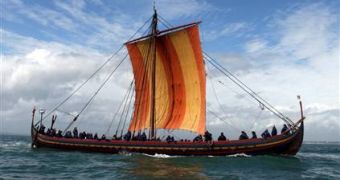If we take a look at modern-day Danish people, they do not seem to resemble their ancestors, the bloody Viking warriors. Still, a modern day replica of a Viking ship has managed to re-create the route of the ancient Vikings, entering Dublin's harbor on Tuesday, after an arduous 1,000-mile (1,600 km) journey from Scandinavia. This time there was no loot.
The six week adventure was possible because of "Stallion of the Sea", a 100-foot (33 m) replica of a Viking ship built in 1042 in Glendalough, Ireland and was made using Viking-era tools.
"Stallion of the Sea" crossed the Northern Sea from Scandinavia, Scotland and the Irish Sea. 1,000 years ago, the Vikings used this pathway to attack Ireland and Dublin itself was founded by them in 841.
The 65-member crew faced violent waters and high winds, but they were greeted by spectators, while they blew their horns as the ship entered the harbor in Dublin.
"In Denmark, we are certainly proud of this ship, but we are not proud of the damages to the people of Ireland that followed in the footsteps of the Vikings. But the warmth and friendliness with which you greet us today and the Viking ship show us that, luckily, it has all been forgiven." said Danish culture minister Brian Mikkelsen, watching the show.
The Vikings started their expeditions mainly from Denmark and Norway and started plundering in the 8th-10th centuries in northwestern Europe, including Ireland and Britain, and even briefly conquered a vast stretch of England. Denmark's royal dynasty is related to the Viking king Gorm the Old, who died in 958.
Vikings' navigational skills still amaze the researchers and this ship had attempted to simulate a Viking voyage from Scandinavia to Ireland; still, it benefited from some equipment Vikings were unaware of: a support ship, global positioning systems, radar, radio, life jackets, survival gear and satellite weather forecasts.
Initially, the crew attempted to make a journey from Roskilde (eastern Denmark) to Dublin, just like Vikings did, based only on the wind and rowing. But due to the dangerous winds, the ship had to be towed 345 miles (550 km) across the North Sea.
"It would have been too difficult - and dangerous - to completely recreate the original sea crossing. We modern people cannot in the course of one summer season make up for the navigational experience and feeling of weather-hardened Viking Age professionals," said Anton Englert, curator at the Viking Ship Museum in Roskilde, which keeps the original of the ship "Stallion of the Sea".
The crew had been blogging from the boat and the progress of the ship could be watched with Google Earth. "The ship's arrival in Ireland would close an archaeological circle, returning a copy of the ship to where the original was made." said Englert.

 14 DAY TRIAL //
14 DAY TRIAL //